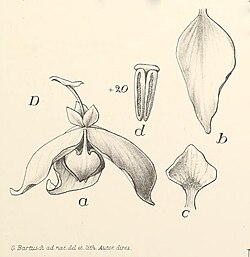Biology:Monodora junodii
| Monodora junodii | |
|---|---|

| |
| Botanical illustration of a Monodora junodii flower and floral parts.[1] | |
| Scientific classification | |
| Kingdom: | Plantae |
| Clade: | Tracheophytes |
| Clade: | Angiosperms |
| Clade: | Magnoliids |
| Order: | Magnoliales |
| Family: | Annonaceae |
| Genus: | Monodora |
| Species: | M. junodii
|
| Binomial name | |
| Monodora junodii Engl. & Diels
| |
Monodora junodii is a species of plant in the family Annonaceae. It is native to Eswatini, Kenya, Malawi, Mozambique, South Africa , Tanzania, and Zimbabwe.[3] Heinrich Gustav Adolf Engler and Ludwig Diels, the German botanists who first formally described the species, named it after Henri-Alexandre Junod, the Swiss missionary and scientist who collected the specimen that they examined.[4]
Description
It is a tree reaching 7 meters in height. Its branches have lenticels. Its leaves are 6.5–16.5 by 3–5.5 centimeters and come to a point at their tips. The leaves are smooth on their upper and lower surfaces. Its petioles are 1–6 millimeters long. Its pendulous flowers are odorless, solitary and axillary or extra-axillary. Each flower is on a pedicel 0.8–2 centimeters long. Its flowers have 3 slightly hairy, green sepals that are 5–10 millimeters longwith rounded tips. Its 6 petals are arranged in two rows of 3. The outer petals are 2–3.5 by 1.6–2.7 centimeters and yellow when young, but turning puce or purple when mature. The inner petals are similarly colored, have a 0.7–1.0 centimeter long claw at their base and a 1–1.6 by 1.4–2.1 centimeter wide blade. The inner petals are hairy with the exception of the upper side of the claw. Its stamens are 0.5 millimeters long. Its wrinkled, smooth fruit are globe shaped and 4–5 centimeters in diameter and are greenish-grey with brown highlights. Its light yellow-brown, flat, oval-shaped seeds are 1.5–2 centimeters long.[4][5]
Reproductive biology
The pollen of M. junodii is shed as permanent tetrads.[6]
Habitat and distribution
It has been observed growing in sandy soil in lowland and evergreen forests at elevations from 0–900 meters.[6]
References
- ↑ Diels, Ludwig; Engler, Adolf; Gilg, Ernst; Schumann, K. (1901) (in de, la). Monographieen afrikanischer Pflanzen-Familien und -Gattungen. Leipzig: W. Engelmann. https://www.biodiversitylibrary.org/item/113590.
- ↑ Cosiaux, A.; Couvreur, T.L.P.; Erkens, R.H.J. (2019). "Monodora junodii". IUCN Red List of Threatened Species 2019: e.T62587A133041916. doi:10.2305/IUCN.UK.2019-3.RLTS.T62587A133041916.en. https://www.iucnredlist.org/species/62587/133041916. Retrieved 20 November 2021.
- ↑ "Monodora junodii Engl. & Diels". The Trustees of the Royal Botanic Gardens, Kew. n.d.. https://powo.science.kew.org/taxon/urn:lsid:ipni.org:names:74133-1.
- ↑ 4.0 4.1 Engler, A.; Diels, L. (1899). "Anonaceae" (in German, Latin). Notizblatt des Königlichen Botanischen Gartens und Museums zu Berlin 2 (17): 292–302. https://www.biodiversitylibrary.org/item/91418.
- ↑ Robson, N.K.B. (1960). "Annonaceae". in Exell, A.W.; Wild, H.. Flora Zambesiaca. London: Royal Botanic Gardens, Kew. http://apps.kew.org/efloras/namedetail.do?qry=namelist&flora=fz&taxon=294&nameid=972.
- ↑ 6.0 6.1 Couvreur, Thomas L. P. (2009). "Monograph of the Syncarpous African Genera Isolona and Monodora (Annonaceae)". Systematic Botany Monographs 87: 1–150.
Wikidata ☰ Q17140317 entry
 |


